By AL JAZEERA
On May 30, the United States accused China of intercepting one of its spy planes in an “unnecessarily aggressive manoeuvre” over the South China Sea. The American RC-135 plane, according to the US military, was conducting routine operations over the sensitive waterway when the Chinese fighter jet flew directly in front of its nose.
A video shared by the US Indo-Pacific Command showed the cockpit of the RC-135 shaking in the wake of turbulence of the Chinese jet.
Days later, on June 5, the US again accused China of carrying out what it said was an “unsafe” manoeuvre near one of its vessels. This time it was around a warship in the Taiwan Strait. The US Indo-Pacific Command again released a video of the incident, showing a Chinese navy vessel cutting sharply across the path of a US destroyer at a distance of some 137 metres (150 yards), forcing the latter to slow down to avoid a collision.
Washington said the near misses showed China’s “growing aggressiveness”, but Beijing said the US was to blame, accusing its rival of deliberately “provoking risk” by sending aircraft and vessels for “close in reconnaissance” near its shores – moves it said posed a serious danger to its national security.
The close calls evoked memories of a deadly incident on April 1, 2001, when a Chinese fighter jet and a US surveillance plane collided in the sky over the South China Sea. The impact caused the Chinese jet to crash and killed the pilot, while the US plane was forced to make an emergency landing in China’s Hainan. Beijing held the 24 American aircrew members for 11 days and only released them when Washington apologised for the incident.
While the two countries were able to de-escalate tensions then, there are worries that a similar mishap today could widen into a bigger conflict due to the deterioration in relations between the rivals.
The US views China as the biggest challenge to the Western-dominated international order, pointing to Beijing’s rapid military buildup – the biggest in peacetime history – as well as its claims over the self-governed island of Taiwan and in the East and South China Seas. The US military’s so-called “freedom of navigation exercises” in the contested waterways near China are part of a push by the administration of President Joe Biden to deepen and expand its diplomatic and military presence in the Asia Pacific.
The campaign – which has accelerated over the past year – stretches from Japan to the Philippines and Australia, and from India to Papua New Guinea and the Solomon Islands. The “once in a generation effort,” as Gregory Poling, director of the Southeast Asia Program at the Center for Strategic and International Studies, puts it, involves the opening of new embassies in the region, deployment of troops and more advanced military assets, as well as obtaining access to sites in key areas facing the South China Sea and the Taiwan Strait.
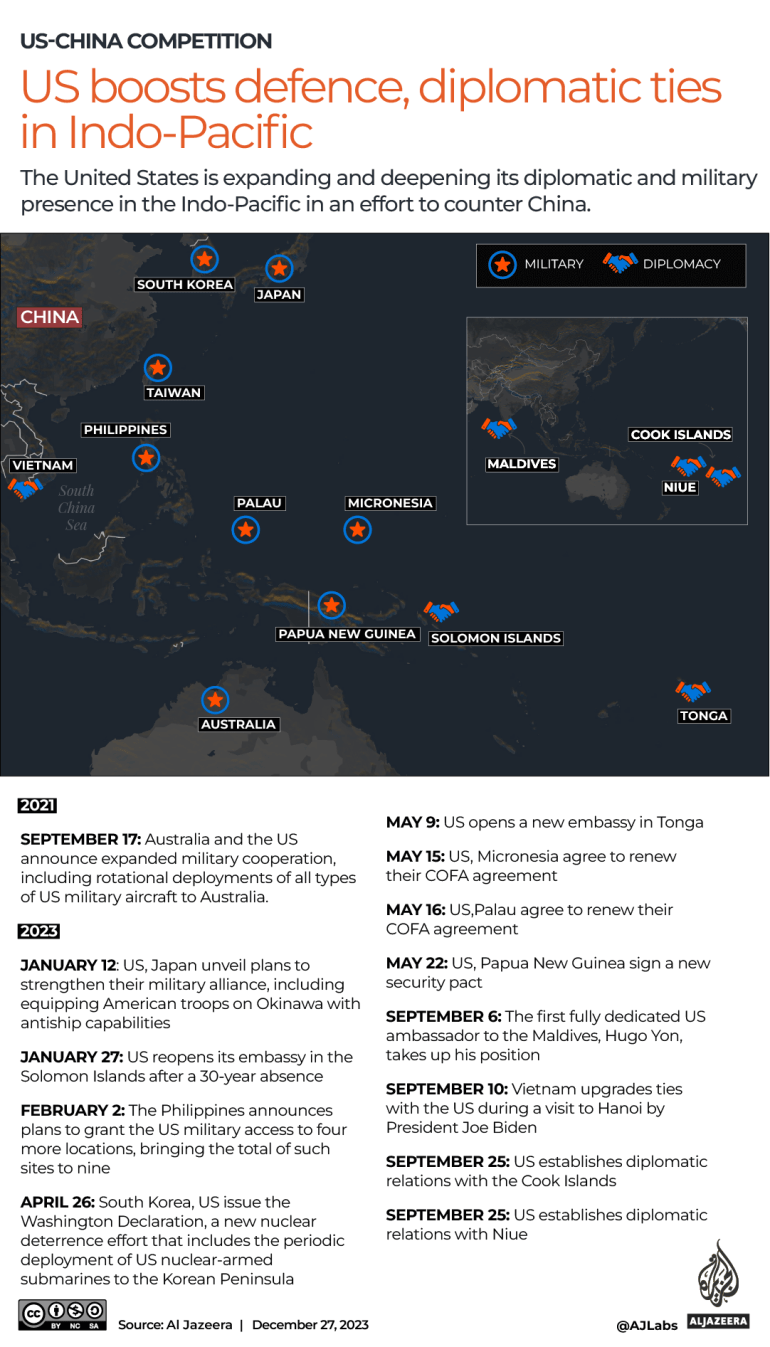
For its part, China accuses the US of pursuing a policy of “containment, encirclement and suppression”, all aimed at holding back its economic development. And its leaders have pledged to resist.
Chinese President Xi Jinping said the US campaign has “brought unprecedented severe challenges to our country’s development”, and in a speech in March called on his countrymen to “dare to fight”. His former Defence Minister Li Shangfu, during an address at the Shangri-La Dialogue in Singapore, condemned what he called Washington’s “Cold War mentality”, and said Beijing would not be intimidated and would “resolutely safeguard national sovereignty and territorial integrity, regardless of any cost”.
Analysts say tensions will only heighten further as competition between China and the US – a contest about who gets to set the rules on the global stage – intensifies. While the superpower rivalry could bring benefits to countries in the Asia Pacific in the short term – particularly in the form of infrastructure loans and foreign direct investments – these nations could, in the future, find having to navigate between China and the US more challenging.
“This is a competition over what the rules-based order looks like, at least in Asia,” Poling told Al Jazeera. “It’s about whether or not the existing global rules continue to apply to Asia or whether China gets to carve out a huge area of exemption in which its preferred rules predominate.
“Clearly, the next couple of decades at least are going to be characterised by this growing competition. Unless China changes its strategy on this … then we’re going to see competition continue to heighten and tensions continue to heighten not just between the US and China, but also between China and most of its neighbours.”
China’s rise
Japan’s defeat in World War II ushered in an age of US dominance in Asia. But in recent decades, China’s growing military and economic might has brought an end to that uncontested primacy.
Under Xi, who took office in 2012 championing what he calls the “Chinese dream of national rejuvenation”, a vision to restore China’s great-power status, Beijing has invested heavily in modernising its military. According to the International Institute for Strategic Studies, a London-based think tank, China has more than doubled its military spending over the past decade, with expenditure reaching $219bn in 2022 – although this is still less than a third of US spending during the same year.
China has also embarked on a naval shipbuilding programme that has put more vessels to sea between 2014 and 2018 than the total number of ships in the German, Indian, Spanish and British navies combined. The People’s Liberation Army (PLA) has since also commissioned guided missile cruisers as well as nuclear-powered ballistic missile submarines. In June 2022, it launched its third aircraft carrier, the Fujian. The PLA’s rocket force has also modernised its capabilities, including with the development of hypersonic missiles and anti-ship ballistic missiles. According to the US military, the PLA also plans to accelerate the expansion of its nuclear arsenal to as many as 700 nuclear warheads by 2027 and at least 1,000 by 2030.
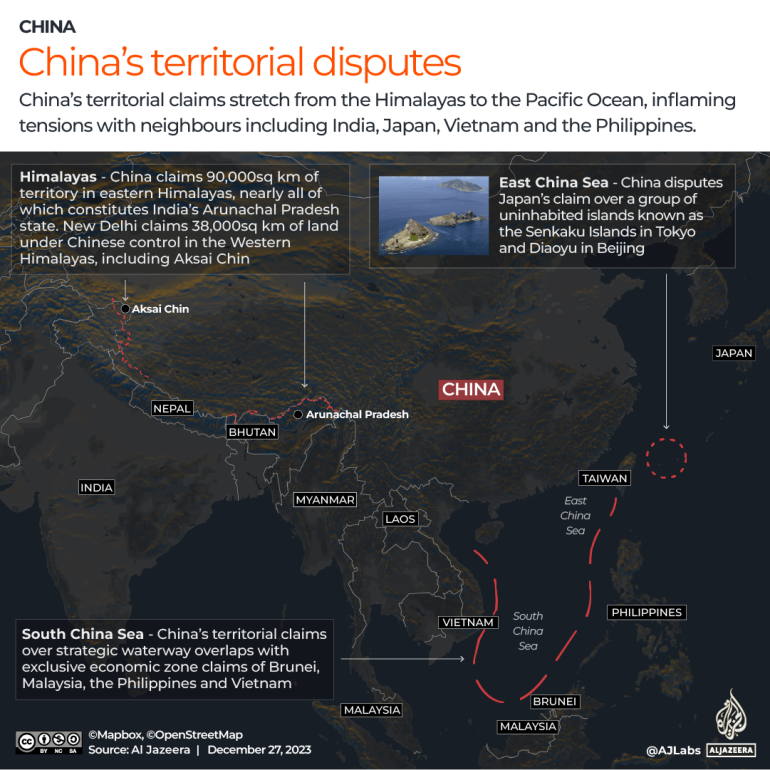
Along with the military build-up, China has also become increasingly assertive in enforcing its territorial claims in crucial waterways off its coast.
In the East China Sea, Beijing lays claim to a group of Japanese-administered islands known as Diaoyu in China and Senkaku in Japan and has increased naval and aerial patrols in the area, drawing protests from Tokyo.
China also lays claim to the entire South China Sea, via its nine-dash line, much to the ire of neighbouring Philippines, Vietnam, Taiwan, Brunei and Malaysia. To shore up those claims, China has built artificial islands in disputed waters, including in the Spratly Islands which it seized from the Philippines in 1996, and expanded its presence in the Paracel Islands which it seized from Vietnam in 1976. China now operates four large outposts with 10,000-foot runways on Woody Island, Fiery Cross Reef, Mischief Reef and Subi Reef. It has also deployed substantial military assets to the islands, including anti-ship missiles, and hangars capable of housing military transport, patrol and combat aircraft.
At the same time, China has faced off with India over their disputed border in the Himalayas. Tensions in the region boiled over in June 2020, when Chinese and Indian troops fought each other with sticks and clubs. At least 20 Indian and four Chinese soldiers died.
Xi has also stepped up rhetoric around Taiwan.
During the Chinese Communist Party’s Congress in September, Xi called unification with the democratically-governed island a “historic mission” and an “unshakable commitment”. The PLA has meanwhile normalised incursions into Taiwan’s Air Defense Identification Zone, the airspace in which Taiwan attempts to identify and control all aircraft.
On the economic front, too, China has grown increasingly powerful.
It is the most important trading partner for more than 120 countries in the world and has sought to expand its economic influence through the ambitious Belt and Road Initiative (BRI). Under the project, sometimes known as the New Silk Road, China has financed physical infrastructure, such as ports, bridges and railways across Asia, Africa and Europe and funded hundreds of special economic zones, or industrial areas designed to create jobs. To date, some 147 countries have signed on to BRI projects or indicated an interest in doing so. In total, China has already disbursed an estimated $1 trillion on such efforts and may spend as much as $8 trillion over the life of the project.
Arc of alliances
The US has sounded the alarm over China’s growing clout.
Biden has called Xi a “dictator”, while his administration has accused Beijing of leveraging its commercial, military and technological might to “pursue a sphere of influence in the Indo-Pacific” and “become the world’s most influential power”.
Biden’s Secretary of State Antony Blinken, unveiling the US’s China strategy last year, described the Asian power as “the only country with both the intent to reshape the international order and, increasingly, the economic, diplomatic, military and technological power to do it”.
A key pillar in the US’s campaign to counter China has been its efforts to deepen and expand its military and diplomatic ties with countries in the Indo-Pacific. The campaign – which includes boosting relations with allies such as Australia, Japan and South Korea, and non-allies such as India and Vietnam – has arguably resulted in the most robust US diplomatic and military posture in the Asia Pacific in recent decades.
In Australia, the US, along with the United Kingdom, has announced a historic security partnership to equip Canberra with up to five nuclear-powered attack submarines by the early 2030s. These vessels, which are equipped with long-range missiles, are much harder to detect and can stay underwater far longer than conventional submarines, “making them one of the most effective ways to complicate Chinese military planning and give Beijing a reason to take pause before using force”, according to the Carnegie Endowment for International Peace. Australia and the US have also announced plans to increase the rotational presence of US air, land and sea forces on the island continent, and build airfields to operate nuclear-capable B52 bombers from northern Australia.
In Japan, the US has announced plans to overhaul its troop presence on the Okinawa Islands, including equipping its maritime units there with long-range fire abilities that can hit ships – something that would be key in the event of a Chinese invasion of Taiwan.
In South Korea, which has grown increasingly anxious about neighbouring North Korea’s accelerating nuclear and missile programme, the US has announced new security assurances including the deployment of a nuclear-armed submarine to the Korean peninsula for the first time in four decades. More significantly, the US has announced a new trilateral security partnership with Seoul and Tokyo, a historic achievement given the long history of mutual acrimony between the two countries. At a summit in Camp David in the US in August, the three nations condemned China’s “dangerous and aggressive behaviours” in the South China Sea and pledged to deepen military and economic cooperation to tackle regional challenges.
In the Philippines, another US ally, the government of President Ferdinand Marcos Jr – incensed by Chinese harassment of its vessels in the South China Sea – has granted the Pentagon access to four more sites in the country. This brings to nine the number of locations that US forces have access to in the country – albeit on a rotational basis. Three of the four new sites are in the provinces of Cagayan and Isabela in northern Philippines, facing Taiwan, and the other in eastern Palawan, near the disputed Spratly Islands in the South China Sea. The Philippines and the US have also stepped up the scope and scale of their military exercises, and Washington has reinforced its commitment to defend Manila from an attack at sea. The navies of the two countries are eyeing joint naval patrols in the South China Sea, while the US has also increased freedom of navigation exercises in the waterway.
Vietnam, too, has upgraded its ties with the US. Alarmed by China’s actions in the South China Sea, Hanoi in September elevated the US’s diplomatic status to that of a comprehensive strategic partner – on par with that of China and Russia. The move came during a historic visit to the Vietnamese capital by Biden, and experts say it is indicative of the depth of its concern over its territorial dispute with China in the South China Sea.
On Taiwan, Biden has said on several occasions that the US would come to the island’s aid if there was a Chinese attack. While the White House has since walked back those statements, the Biden administration has continued arms sales to Taiwan, approving more than $3bn in weapons transfers and also allowing US officials to meet more freely with Taiwanese counterparts.
In the Pacific Islands, too, the US has expanded its military and diplomatic footprint.
In May, it signed a security deal with Papua New Guinea that gives it “unimpeded access” to several key airports and seaports in the Pacific nation and re-opened an embassy in the Solomon Islands after a 30-year absence. It has also opened an embassy in Tonga and is in talks with Kiribati and Vanuatu to establish a diplomatic presence there. Biden has also hosted historic summits for Pacific Island leaders in Washington, DC, pledging $810m in new aid for the Pacific Islands over the next decade, including to tackle the existential threat of climate change.
Non-aligned India, too, has stepped up cooperation with the US.
The two countries, along with Australia and Japan have revived an informal alliance known as the Quadrilateral Security Dialogue, or Quad, in a bid to counter China and deliver public goods to countries in the Global South. Quad pledges include a key initiative to help countries protect maritime resources from predatory illegal fishing and promises to invest more than $50bn in developing infrastructure in the Indo-Pacific.
‘Desperation’
Analysts say the US campaign has stirred anger and concern in Beijing.
“This latest phase really just shows an increase in desperation on the part of the US because taking military measures usually is a last resort. Because it’s risky and it’s expensive. It’s also very dangerous. A country that has to resort to these measures, I think, clearly feels it is running out of options and is increasingly desperate to protect its rapidly eroding position in the world,” said Andy Mok, senior research fellow at the Center for China and Globalization in Beijing.
“We only need to look at a map of US military assets to see who’s the aggressor. It’s not that China has numerous military bases surrounding the United States. It’s exactly the opposite. So I think any reasonable observer would question this assertion whether China is really engaging in any sort of military provocations here.”
Mok said China is responding to the US’s efforts by continuing its military modernisation as well as strengthening its own ties.
The military modernisation efforts “include everything from the development of hypersonic missiles to a much stronger navy that is effective not just close to China’s shores, which would include Taiwan, of course, but much broader,” he said. “It includes cyber, includes space from the military perspective. So, becoming a much more comprehensive military force able to respond to threats a number of different ways.”
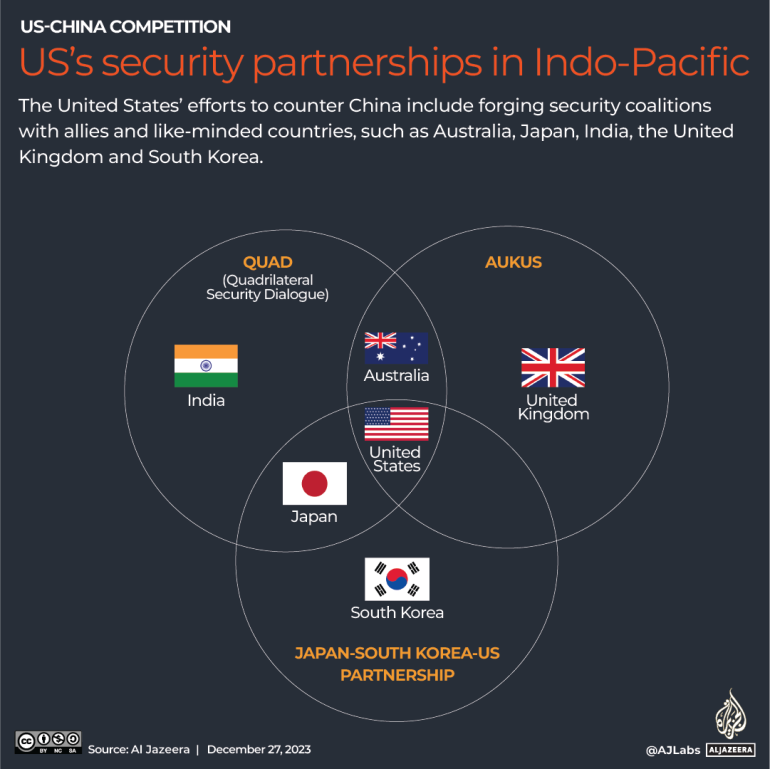
On the diplomatic front, Mok said China will look to strengthen multilateral initiatives such as the Regional Comprehensive Economic Partnership, the world’s largest free trade agreement that brings together 15 countries, the BRICs group that includes Brazil, Russia and India, and the Shanghai Cooperation Organization (SCO), a nine-member Eurasian group that counts Pakistan and Iran among its members.
“These are all attempts to create a more humane and just global order, where these types of issues are, again, not decided by one country and not decided through coercion, whether that’s primarily military coercion or other forms of coercion, including economic sanctions,” he added.
Heightened tensions
For countries in the Asia Pacific, especially in Southeast Asia, the increased US-China competition has brought some economic benefits. To compete with China’s BRI, the US has pledged to step up investment in infrastructure, though much of this investment has yet to bear fruit, while the trade war between the superpowers has resulted in some Southeast Asian countries marketing themselves as alternative production destinations.
“In Southeast Asia, I think the emphasis is on autonomy. And to the extent that they can invite more actors in to have a stake – whether this is the United States, whether this is Korea, Japan, the EU or Australia – that is somewhat more preferred because it dilutes the presence of any single actor,” said Ja-Ian Chong, associate professor at the National University of Singapore.
“With the diversification of investment from the United States, South Korea, Japan, Taiwan, Australia, some Southeast Asian states will be big beneficiaries. So Vietnam, Thailand, Indonesia, and to some degree, the Philippines and Malaysia have seen investment that might otherwise go to China go to them.”
China, Chong said, sees the robustness of US presence in the region as a bit of a challenge.
“The question is, how they will respond? It is possible that they may respond with more caution, which could be stabilising, but there’s also a possibility that they could react even more strongly. But that’s not easy to predict at this point in time.”
So far, it appears that Beijing is seeking to contest the US’s presence.
That is evident not just in the confrontations between US and Chinese vessels and aircraft over the South China Sea and the Taiwan Strait, but also in Beijing’s standoffs with Philippine military boats in the South China Sea. These include incidents in August and earlier this month when the Chinese Coast Guard used water cannon to prevent the Philippine military from resupplying its troops living on a grounded warship on the disputed Second Thomas Shoal.
On Taiwan, too, China’s navy this year launched its largest-ever exercises in the Pacific Ocean, deploying an aircraft carrier and dozens of naval ships and warplanes, in a move analysts said was probably practice for enforcing a blockade around the island. Beijing said the purpose of the drills was to “resolutely combat the arrogance of Taiwan independence separatist forces and their actions to seek independence”.
Chong said the tensions were likely to pose new challenges to countries in the region.
“I expect the contestation to become more intense. Meaning to say that trying to navigate between the two major powers will become more challenging, not impossible, but certainly more challenging. To expect that you can act in ways that get benefits from both sides may become more difficult. It may be the case that working with one more will invite pressure from the other,” said Chong. “That is likely to be a challenge facing Southeast Asia unless they are more able to set up their own direction.”


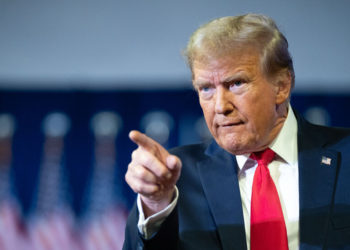
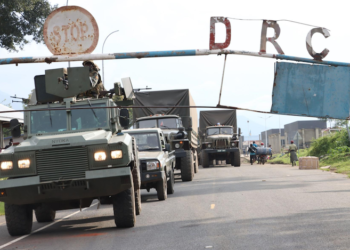
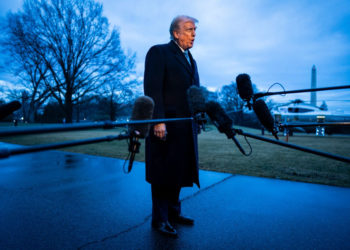


Discussion about this post